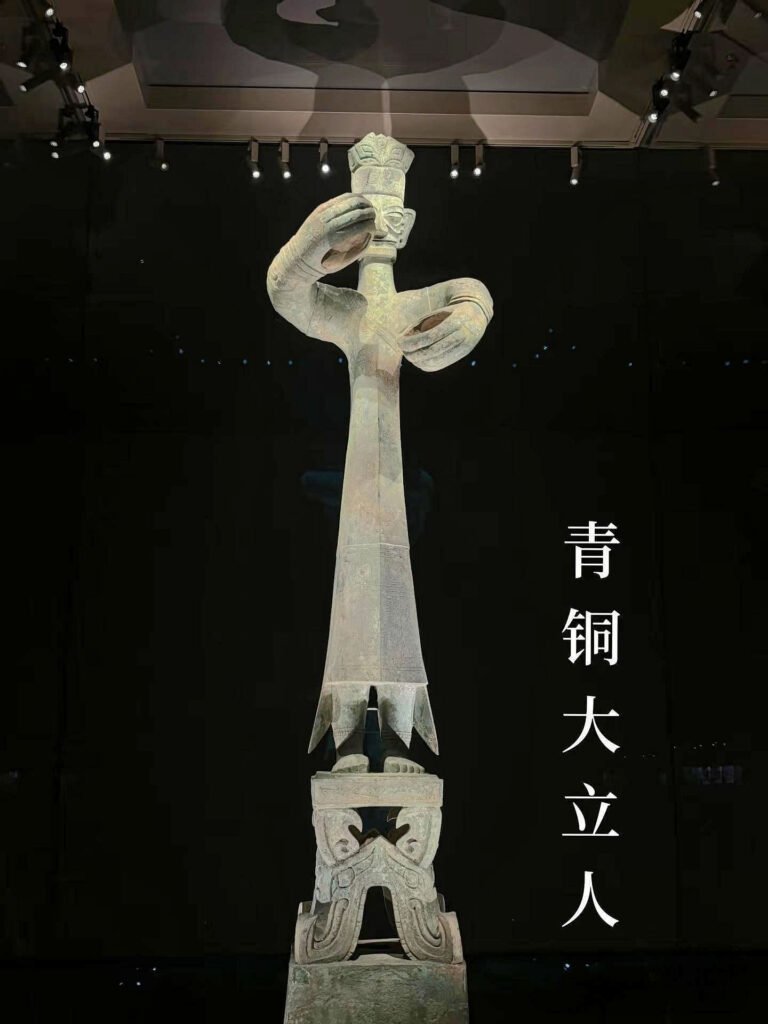
As a native of Guanghan, Sichuan, where the echoes of ancient rituals still linger in the earth, I invite you to explore one of humanity’s most captivating archaeological treasures: the Bronze Standing Figure Sanxingdui. This 3,000-year-old masterpiece, unearthed from our ancestral lands, embodies the genius of a lost civilization and ignites imaginations worldwide. Let me share its story—a blend of history, artistry, and mystery—through the eyes of those who call this sacred ground home.
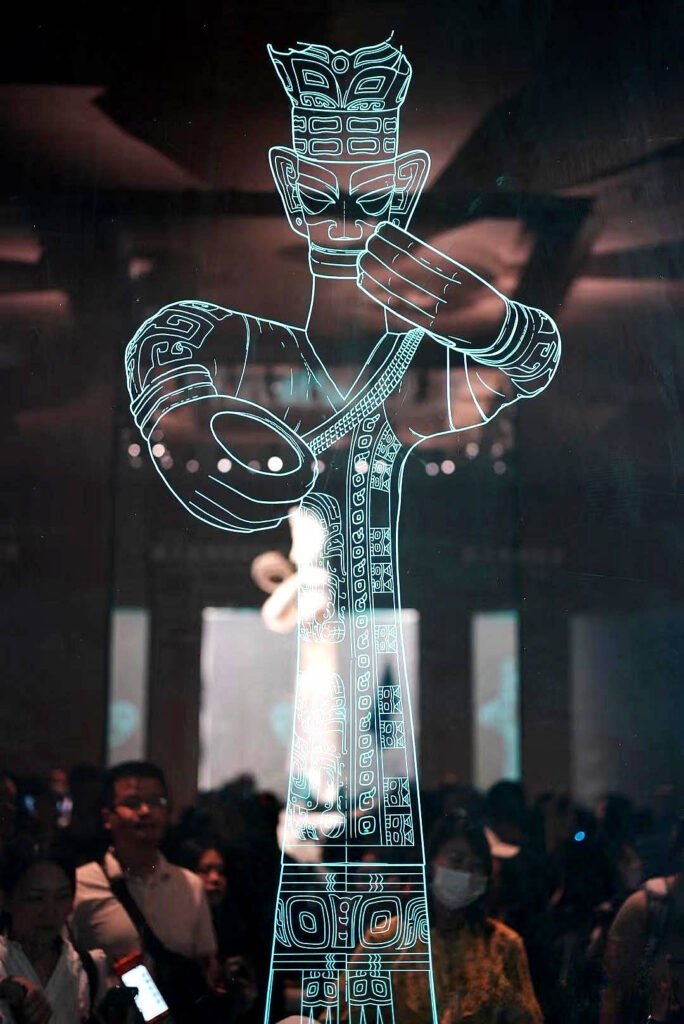
A Colossus Reborn: The Bronze Standing Figure’s Discovery
In 1986, archaeologists excavating Sanxingdui’s Sacrificial Pit No. 2 uncovered fragments of a giant bronze statue lying amidst shattered relics. Painstakingly restored, the Bronze Standing Figure Sanxingdui emerged—a staggering 2.62 meters tall (with a 90 cm base), weighing 180 kilograms, and radiating an otherworldly aura. Dating to the Shang Dynasty (c. 1600–1046 BCE), it is the largest and most complete human-shaped bronze sculpture of its era。
earning titles like “King of Bronze Statues” and “Oriental Colossus”.
Crafted using advanced segmented casting, the figure’s hollow body comprises a human form atop a mythical-beast pedestal. Its features—almond-shaped eyes, a square jaw, and piercing gaze—blend realism with surrealism. Adorned with a three-tiered robe etched with dragons, birds, and cosmic symbols, it wears a floral crown reminiscent of sunbursts, hinting at divine authority.
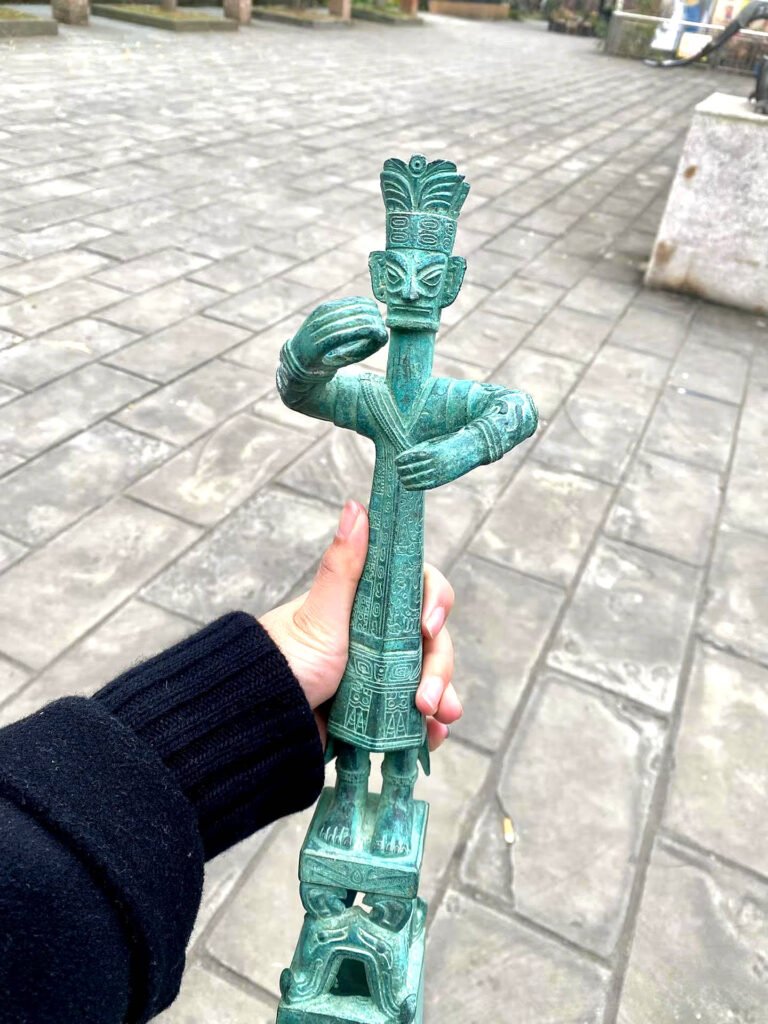
The Hands of Mystery: Ritual, Power, and Cosmic Connection
The Bronze Standing Figure Sanxingdui’s most debated feature is its hands: clenched into hollow circles, positioned as if cradling an object. Scholars have proposed theories:
- A Lost Artifact: Ivory, jade cong (ritual tubes), or a serpent-shaped scepter.
- Symbolic Gesture: Archaeologist Chen Dean suggests it represents a ritual pose—an ascendant motion toward the heavens, akin to a prayer.
- Cosmic “Void”: Taoist parallels link the empty grasp to wuji (primordial chaos), symbolizing the universe’s infinite potential.
The pedestal deepens the enigma. Decorated with sun motifs, cloud patterns, and dragon heads, it depicts the figure rising above a nascent sun—a bridge between earth and sky. To us in Guanghan, this evokes ancestral shamans who mediated with gods through mountains, rivers, and celestial trees.
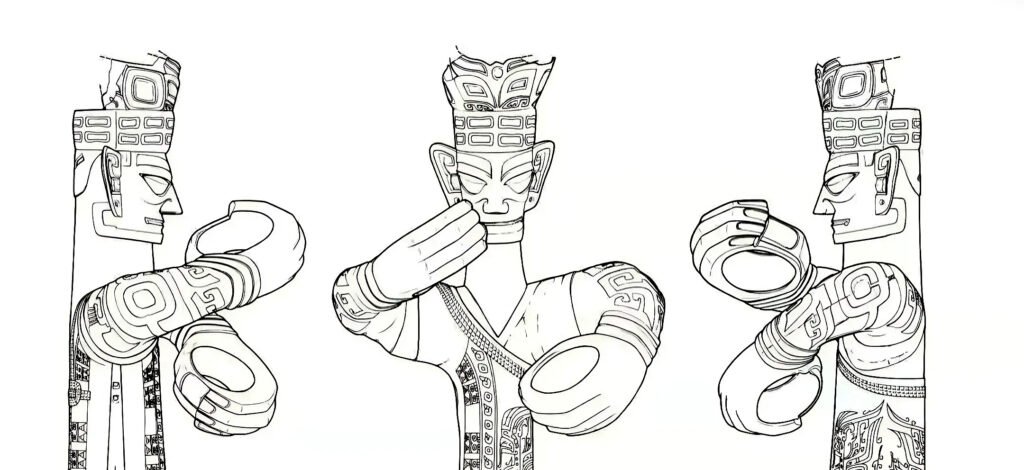
Guanghan: Cradle of the Shu Kingdom
To understand the Bronze Standing Figure Sanxingdui, one must know its homeland. Sanxingdui (meaning “Three-Star Mounds”) lies near Guanghan City in Sichuan Basin, a fertile realm shielded by mountains yet connected via river valleys to Tibet, Yunnan, and the Yangtze. For millennia, this crossroads nurtured the Shu Kingdom, a Bronze Age civilization (c. 2000–1000 BCE) rivaling contemporaneous cultures like Shang China and Mycenaean Greece.
Shu’s origins trace to semi-legendary kings:
- Can Cong (associated with silkworms), who dwelled in Qionglai Mountains;
- Yu Fu (the “Fish Owl”), linked to waterfowl worship;
- Du Yu, the agrarian ruler who taught rice cultivation.
The Bronze Standing Figure Sanxingdui likely depicts a theocratic monarch—a fusion of king, high priest, and deity. Its layered silk robes, dragon insignia, and solar crown suggest control over nature and cosmos.
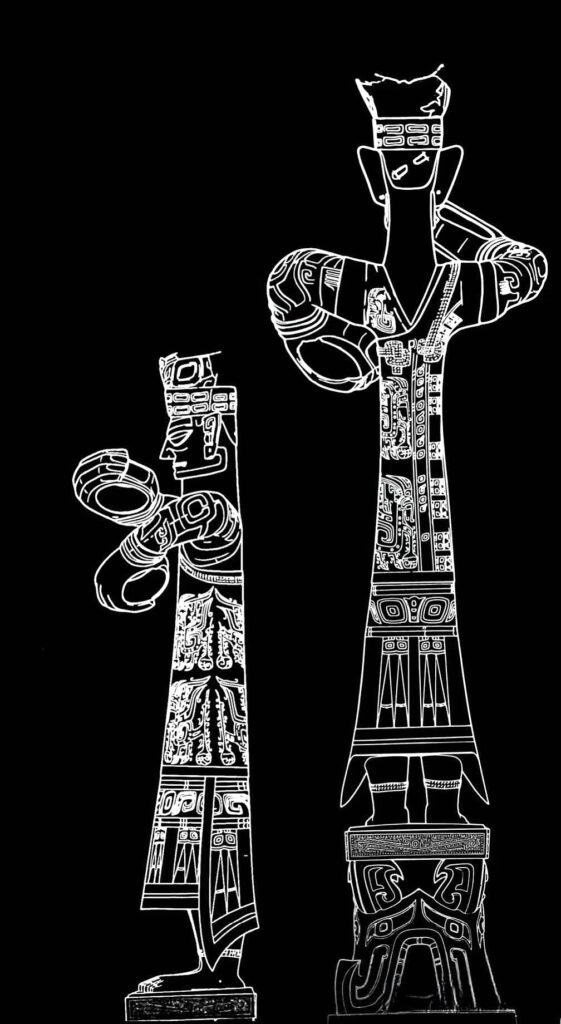
Sanxingdui’s Cultural Explosion and Enigmatic Collapse
Between 1200–1000 BCE, Sanxingdui flourished as Shu’s capital. Its artisans mastered bronze, gold, and jade, producing masks with gilded eyes, sacred trees piercing clouds, and altars teeming with animal-human hybrids. Unlike Shang China’s written records, Shu conveyed power through symbols—hence the Bronze Standing Figure Sanxingdui’s visceral impact.
Yet around 1000 BCE, the civilization vanished. Ritual objects—including our bronze giant—were smashed, burned, and buried in pits, perhaps to “deactivate” their spiritual potency during a crisis. Theories for Shu’s fall range from earthquakes to invasions, but its legacy endured. Later Shu states (like Ba and Chu) absorbed its motifs, and Taoist traditions may echo its cosmic rituals.
A Beacon for Modern Seekers
Today, the Bronze Standing Figure Sanxingdui presides over Guanghan’s Sanxingdui Museum, where millions marvel at its fusion of humanity and divinity. Recent excavations (2020–2022) revealed six new pits, yielding gold masks and bronze altars that reaffirm Shu’s sophistication. For us locals, this statue is more than art—it’s a spiritual anchor.
As Sichuan embraces its role as China’s “Land of Abundance” (Tianfu Zhi Guo), the Bronze Standing Figure Sanxingdui symbolizes resilience. It challenges us to ponder:
- How did Bronze Age people cast such a monumental Bronze Standing Figure Sanxingdui without modern tools?
- What songs echoed as priests mimicked its stance in temple courtyards?
- Might its empty hands hold answers to human creativity itself?

Conclusion: An Eternal Icon
The Bronze Standing Figure Sanxingdui transcends time. To global visitors, it offers a glimpse into a civilization that redefined Bronze Age artistry. To Guanghan’s people, it is a silent guardian—a testament to Shu’s vision of harmony between earth, sky, and human ingenuity. As excavations continue, each discovery whispers: The past is not dead. It awaits in the soil, ready to speak.
Author Bio: A cultural enthusiast from Guanghan, Sichuan, I grew up hearing legends of Sanxingdui. Today, I share these stories to bridge ancient wisdom and modern curiosity. Follow #SanxingduiStories for more.

